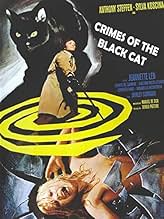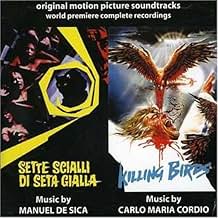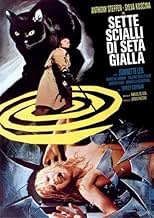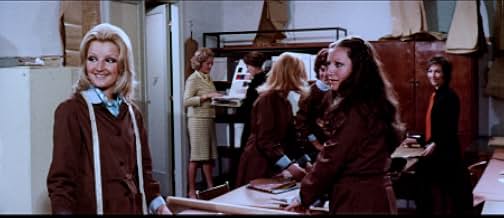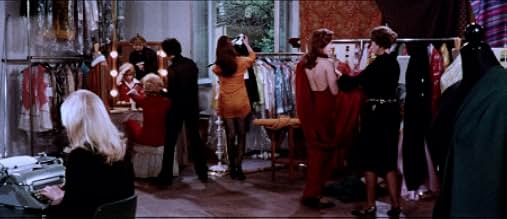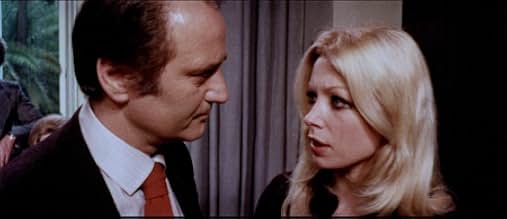VALUTAZIONE IMDb
6,1/10
1113
LA TUA VALUTAZIONE
Aggiungi una trama nella tua linguaA blind pianist overhears a conversation in a nightclub, and is determined to figure out who is responsible for a string of strange murders involving a black cat.A blind pianist overhears a conversation in a nightclub, and is determined to figure out who is responsible for a string of strange murders involving a black cat.A blind pianist overhears a conversation in a nightclub, and is determined to figure out who is responsible for a string of strange murders involving a black cat.
- Regia
- Sceneggiatura
- Star
Giovanna Lenzi
- Susan Leclerc
- (as Jeannette Len)
Isabelle Marchall
- Paola Whitney
- (as Isabelle Marchal)
Lorenzo Piani
- Waiter in Hamburg
- (solo nei titoli)
Bruno Alias
- Hairdresser
- (non citato nei titoli originali)
Francesco Anniballi
- Male Nurse
- (non citato nei titoli originali)
Florinda Bolkan
- Carol Hammond
- (filmato d'archivio)
- (non citato nei titoli originali)
Margherita Horowitz
- Atelier personnel
- (non citato nei titoli originali)
Recensioni in evidenza
Stop me if you've heard this one before (don't really though) - a black hatted, gloved killer is working his way through the models at a fashion house. Blind composer Anthony Steffan gets caught up in all this nonsense because the first victim is his girlfriend Paola, who about ten seconds previously, dumped the poor guy by letter. That's right - a blind guy, dumped by letter.
Add to that the strange conversation Anthony overhears in his local bar. Someone seems to be blackmailing someone else to do something, but then an annoying hippy throws on a 'groovy' record to 'freak out' to, and Anthony only hears about half the conversation. The waiter describes a woman in a white cape to Anthony, but the other conversationalist must have slipped out a back door, because the waiter didn't seem them. Can I add here however that the record lasts about fifty seconds. Thank God it wasn't some prog or something.
The next day Paola is found dead at the fashion house. It's a kind of locked room mystery, as no one else was there, she has a slight scratch on her face, and there's a yellow shawl lying nearby. Model Margot swears there was a basket in the room too, but that's disappeared. The annoying police, plus Anthony (with sidekick butler Umberto Raho in tow) get right on the case.
There's plenty of suspects too, from hunky Giacomo Rossi-Stuart, second in command at the fashion house and a fanny rat to boot, then there's his missus, the boss of the place. There's also your usual lesbians involved, some gossips, slags, blackmailers. You know the drill by now.
Anthony maybe be blind, but he's no fool. He's one step in front of the police, but one step behind the killer, and what's his dead girlfriend doing in supposed blackmail pictures with Giacomo Rossi-Struart? Someone else gets the old yellow shawl/scratch killing, and Giacomo gets closer to the killer, or at least the person being forced to set up these killings - using his sense of smell!
Sure it's derivative of Mario Bava's Blood and Black Lace (the fashion house) and Argento's Bird With A Crystal Plumage (with the tape recorded clue, and Umberto Raho), there's still loads to enjoy here. There's a great colour scheme (mostly yellow of course!) and Anthony's character is composing the soundtrack to a giallo! When you see footage of it, you'll notice it's Lucio Fulci's Lizard In A Woman's Skin, and as an added bonus, it's the bit that reveals the killer. Good work there.
There's the scene where a character leads Anthony to an glass recycling plant (I think...in 1972?) and leaves him to injure himself amongst all the glass and sudden drops, and a razor killing in a shower that takes the gore level way beyond anything else seen prior to it in the film. The Copenhagen setting is different from the norm too.
Add to that the strange conversation Anthony overhears in his local bar. Someone seems to be blackmailing someone else to do something, but then an annoying hippy throws on a 'groovy' record to 'freak out' to, and Anthony only hears about half the conversation. The waiter describes a woman in a white cape to Anthony, but the other conversationalist must have slipped out a back door, because the waiter didn't seem them. Can I add here however that the record lasts about fifty seconds. Thank God it wasn't some prog or something.
The next day Paola is found dead at the fashion house. It's a kind of locked room mystery, as no one else was there, she has a slight scratch on her face, and there's a yellow shawl lying nearby. Model Margot swears there was a basket in the room too, but that's disappeared. The annoying police, plus Anthony (with sidekick butler Umberto Raho in tow) get right on the case.
There's plenty of suspects too, from hunky Giacomo Rossi-Stuart, second in command at the fashion house and a fanny rat to boot, then there's his missus, the boss of the place. There's also your usual lesbians involved, some gossips, slags, blackmailers. You know the drill by now.
Anthony maybe be blind, but he's no fool. He's one step in front of the police, but one step behind the killer, and what's his dead girlfriend doing in supposed blackmail pictures with Giacomo Rossi-Struart? Someone else gets the old yellow shawl/scratch killing, and Giacomo gets closer to the killer, or at least the person being forced to set up these killings - using his sense of smell!
Sure it's derivative of Mario Bava's Blood and Black Lace (the fashion house) and Argento's Bird With A Crystal Plumage (with the tape recorded clue, and Umberto Raho), there's still loads to enjoy here. There's a great colour scheme (mostly yellow of course!) and Anthony's character is composing the soundtrack to a giallo! When you see footage of it, you'll notice it's Lucio Fulci's Lizard In A Woman's Skin, and as an added bonus, it's the bit that reveals the killer. Good work there.
There's the scene where a character leads Anthony to an glass recycling plant (I think...in 1972?) and leaves him to injure himself amongst all the glass and sudden drops, and a razor killing in a shower that takes the gore level way beyond anything else seen prior to it in the film. The Copenhagen setting is different from the norm too.
(aka: THE CRIMES OF THE BLACK CAT)
Filmed in Denmark with a largely Italian cast in a setting away from the usual Italian locations for this genre. So forget that these people are Danes speaking Italian. You can't be too specific with a film like this.
OK so you've seen this before and if you've seen BLOOD AND BLACK LACE, then you'll know how it turns out. Even so, this really isn't bad watching and the story is constructed well despite a couple of suspense contrivances for the audience like footsteps approaching a door, expecting the viewer to believe it's the killer when it turns out to be the hotel bellboy delivering breakfast.
Blind composer Peter Oliver (spaghetti western star, Anthony Steffen) helps sleuth the murders of fashion models in swanky Copenhagen after his close friend Paola is murdered. He suspects something is wrong when he overhears a conversation about a crime in a restaurant while waiting for Paola to show up. She never does. It turns out Paola is blackmailing Victor (Giacomo Rossi-Stuart), threatening to expose some incriminating photographs to his wife (Sylvia Koscina).
Of course when it comes to this genre, the murders can't always be done in a straightforward way and one particular device is using a black cat who's hands are dipped in curare, scratching the victims and causing them to have heart attacks. Strange, yes, but that's typical of the genre so one has to suspend disbelief if you want to watch films like this.
I won't reveal who the name of the killer is. You'll have to see that for yourself, but I will say that it ends in one of those typical freeze-frame endings that were popular in the 1970s.
The DVD by Degored is of poor quality, taken from videotape source with dropouts appearing occasionally and muffled sound, although the subtitles in English look pretty accurate.
There are worse out there.
5 out of 10
Filmed in Denmark with a largely Italian cast in a setting away from the usual Italian locations for this genre. So forget that these people are Danes speaking Italian. You can't be too specific with a film like this.
OK so you've seen this before and if you've seen BLOOD AND BLACK LACE, then you'll know how it turns out. Even so, this really isn't bad watching and the story is constructed well despite a couple of suspense contrivances for the audience like footsteps approaching a door, expecting the viewer to believe it's the killer when it turns out to be the hotel bellboy delivering breakfast.
Blind composer Peter Oliver (spaghetti western star, Anthony Steffen) helps sleuth the murders of fashion models in swanky Copenhagen after his close friend Paola is murdered. He suspects something is wrong when he overhears a conversation about a crime in a restaurant while waiting for Paola to show up. She never does. It turns out Paola is blackmailing Victor (Giacomo Rossi-Stuart), threatening to expose some incriminating photographs to his wife (Sylvia Koscina).
Of course when it comes to this genre, the murders can't always be done in a straightforward way and one particular device is using a black cat who's hands are dipped in curare, scratching the victims and causing them to have heart attacks. Strange, yes, but that's typical of the genre so one has to suspend disbelief if you want to watch films like this.
I won't reveal who the name of the killer is. You'll have to see that for yourself, but I will say that it ends in one of those typical freeze-frame endings that were popular in the 1970s.
The DVD by Degored is of poor quality, taken from videotape source with dropouts appearing occasionally and muffled sound, although the subtitles in English look pretty accurate.
There are worse out there.
5 out of 10
One thing you can say about Italian gialli: they never resort to killing someone with a simple shooting or stabbing--the villains always use some ridiculously elaborate Rube Goldberg method for doing their victims in. And this giallo features what might be the most ridiculous of them all. I don't want to give too much away, but I will say that the English title "Crimes of the Black Cat" can be taken completely literally. (Obviously, the people who thought up this movie were not cat owners--have you ever tried to get a cat to do ANYTHING?). Aside from the especially absurd murders this is a typical giallo. It is set in the European fashion world, it's highly stylized, the plot makes little sense, and the motivation of the villain turns out to be even more ludicrous than the method of murder.
The protagonist is the blind male lover of the first murder victim. (How come blind people never complain that they are always being stereotyped as good-looking and resourceful individuals who always get to solve the crime and sleep with many attractive members of the opposite sex along the way?). The only name star is Sylva Koscina, but she is barely in the movie. The best actor though is the cat (perhaps the self-same feline thespian who played "Satan" in "Gently, Before She Dies"). After he exits the film, it quickly spirals downward with a truly tasteless shower murder and one of those abrupt freeze-frame endings that were so big in the 70's (maybe they ran out of film a lot back then). If you like gialli at all though, you'll probably like this one. It's very typical for its kind.
The protagonist is the blind male lover of the first murder victim. (How come blind people never complain that they are always being stereotyped as good-looking and resourceful individuals who always get to solve the crime and sleep with many attractive members of the opposite sex along the way?). The only name star is Sylva Koscina, but she is barely in the movie. The best actor though is the cat (perhaps the self-same feline thespian who played "Satan" in "Gently, Before She Dies"). After he exits the film, it quickly spirals downward with a truly tasteless shower murder and one of those abrupt freeze-frame endings that were so big in the 70's (maybe they ran out of film a lot back then). If you like gialli at all though, you'll probably like this one. It's very typical for its kind.
The first half of this giallo is fairly undistinguished, especially since it blatantly copies Mario Bava (the fashion-house setting being lifted, yet again, from BLOOD AND BLACK LACE [1964]) and Dario Argento (borrowing its blind hero-turned-sleuth from THE CAT O'NINE TAILS [1971]). However, the film is stylish enough (particularly the zoom-happy murder sequences) and the plot convoluted enough (taking in a plethora of shady characters invariably involved in adultery, drug-taking, blackmail and revenge) to overcome its basic lack of originality; the circus-world back-story, then, should perhaps excuse its uniquely far-fetched murder method...though the seven yellow-silk shawls referred to in the original Italian title are equally insignificant!
The film's pulsating score by Manuel De Sica (son of neo-realist master film-maker and versatile actor Vittorio De Sica) is serviceable but unremarkable, as is the cast led by Anthony Steffen, Sylva Koscina (in what at first appears to be merely an extended cameo) and Giacomo Rossi-Stuart. Its use of nudity is very discreet (though it doesn't appear that any cutting was done, I haven't been able to establish the film's correct running time; the print I watched was around 94 mins. in PAL format, but some sources list versions running as long as 108 mins.!) and the gore only truly surfaces at the very end (with a particularly nasty shower murder, shamelessly ripping off Hitchcock's PSYCHO [1960] - but remaining, for my money, one of the genre's most memorable set-pieces). After the mystery has supposedly been solved (and the revelation of the killer's identity having thus proved quite lame and lazy, in my opinion), the film manages to pull the rug from under our feet - so much so that I had to watch the ending twice! - by providing one final twist. By the way, the decision to conclude the film in mid-sequence on a freeze-frame is another Argento influence, namely FOUR FLIES ON GREY VELVET (1971)!
All in all, a giallo more interesting in its borrowings than for any individual achievements - but one that remains eminently watchable just the same.
The film's pulsating score by Manuel De Sica (son of neo-realist master film-maker and versatile actor Vittorio De Sica) is serviceable but unremarkable, as is the cast led by Anthony Steffen, Sylva Koscina (in what at first appears to be merely an extended cameo) and Giacomo Rossi-Stuart. Its use of nudity is very discreet (though it doesn't appear that any cutting was done, I haven't been able to establish the film's correct running time; the print I watched was around 94 mins. in PAL format, but some sources list versions running as long as 108 mins.!) and the gore only truly surfaces at the very end (with a particularly nasty shower murder, shamelessly ripping off Hitchcock's PSYCHO [1960] - but remaining, for my money, one of the genre's most memorable set-pieces). After the mystery has supposedly been solved (and the revelation of the killer's identity having thus proved quite lame and lazy, in my opinion), the film manages to pull the rug from under our feet - so much so that I had to watch the ending twice! - by providing one final twist. By the way, the decision to conclude the film in mid-sequence on a freeze-frame is another Argento influence, namely FOUR FLIES ON GREY VELVET (1971)!
All in all, a giallo more interesting in its borrowings than for any individual achievements - but one that remains eminently watchable just the same.
"Sette scialli di seta gialla" (Crimes of the black cat) takes place in Copenhagen. The grey subdued skies of Copenhagen and the meditative soundtrack of Manuel de Sica, are a preparation for the giallo we are about to see - a blind pianist, Peter Oliver (Anthony Steffen) investigating a string of murders of fashion models.
Paola Whitney (Isabelle Marchal), Peter Oliver's girlfriend, is murdered, and the police, the other models no one knows exactly what happened and the reason why it happened. She was alone in her room in the fashion house, and then suddenly
Peter Oliver suspects that one of the reasons may be blackmail (fragments of a strange conversation overheard in a bar led him to this conclusion), but nothing really seems to explain the mystery. So Peter Oliver, with the help of his butler Burton (Umberto Raho) and beautiful Margot (Shirley Corrigan) - secretary of Françoise Ballais (Sylva Koscina), owner of the fashion house - , decides to investigate on his own the death of Paola. Other murders happen, the killer seems to anticipate each step of Peter, and there are other developments. As to the police, Inspector Jansen (Renato de Carmine) learns to respect the deductive powers of Peter. Sometimes the case seems about to be solved, but
Besides the characters already mentioned, there are, of course, many gorgeous fashion models (some about to be sacrificed), there's Victor Morgan (Giacomo Rossi-Stuart) that is, so to say, married to Françoise Ballais, and has already experienced troubled waters, and there's also a mysterious junkie woman (Giovanna Lenzi), an important piece in this chess game, and we should not forget the reviled black cat, a very important tool, always followed by a yellow shawl!.
In spite of its many curves, the story is not as convoluted as it seems, and there's one scene in particular that may please gorehounds.
Anthony Steffen, as the blind pianist, demonstrates again his talent and screen charisma and Giovanna Lenzi, as the junkie woman, is another highlight of the film (and the black cat too, of course!).
"Crimes of the black cat" has the visual beauty and style usual in many gialli, the editing is smooth and the film is pleasant to see – feminine beauty peppered with some thrills and violence. Sergio Pastore pays homages to Bava, Argento and... (surprise!), but the film has its own world and atmosphere.
Paola Whitney (Isabelle Marchal), Peter Oliver's girlfriend, is murdered, and the police, the other models no one knows exactly what happened and the reason why it happened. She was alone in her room in the fashion house, and then suddenly
Peter Oliver suspects that one of the reasons may be blackmail (fragments of a strange conversation overheard in a bar led him to this conclusion), but nothing really seems to explain the mystery. So Peter Oliver, with the help of his butler Burton (Umberto Raho) and beautiful Margot (Shirley Corrigan) - secretary of Françoise Ballais (Sylva Koscina), owner of the fashion house - , decides to investigate on his own the death of Paola. Other murders happen, the killer seems to anticipate each step of Peter, and there are other developments. As to the police, Inspector Jansen (Renato de Carmine) learns to respect the deductive powers of Peter. Sometimes the case seems about to be solved, but
Besides the characters already mentioned, there are, of course, many gorgeous fashion models (some about to be sacrificed), there's Victor Morgan (Giacomo Rossi-Stuart) that is, so to say, married to Françoise Ballais, and has already experienced troubled waters, and there's also a mysterious junkie woman (Giovanna Lenzi), an important piece in this chess game, and we should not forget the reviled black cat, a very important tool, always followed by a yellow shawl!.
In spite of its many curves, the story is not as convoluted as it seems, and there's one scene in particular that may please gorehounds.
Anthony Steffen, as the blind pianist, demonstrates again his talent and screen charisma and Giovanna Lenzi, as the junkie woman, is another highlight of the film (and the black cat too, of course!).
"Crimes of the black cat" has the visual beauty and style usual in many gialli, the editing is smooth and the film is pleasant to see – feminine beauty peppered with some thrills and violence. Sergio Pastore pays homages to Bava, Argento and... (surprise!), but the film has its own world and atmosphere.
Lo sapevi?
- QuizAnthony Steffen was dubbed by Edmund Purdom for the English language version.
- BlooperAfter the cat lady's death, the newspaper headline misspells "mystery", as in "The mistery (sic) of the black cat still goes on."
- ConnessioniFeatures Una lucertola con la pelle di donna (1971)
I più visti
Accedi per valutare e creare un elenco di titoli salvati per ottenere consigli personalizzati
- How long is The Crimes of the Black Cat?Powered by Alexa
Dettagli
- Data di uscita
- Paese di origine
- Lingua
- Celebre anche come
- The Crimes of the Black Cat
- Luoghi delle riprese
- Copenaghen, Danimarca(location)
- Aziende produttrici
- Vedi altri crediti dell’azienda su IMDbPro
- Tempo di esecuzione1 ora 35 minuti
- Mix di suoni
- Proporzioni
- 2.35 : 1
Contribuisci a questa pagina
Suggerisci una modifica o aggiungi i contenuti mancanti

Divario superiore
By what name was Sette scialli di seta gialla (1972) officially released in India in English?
Rispondi
